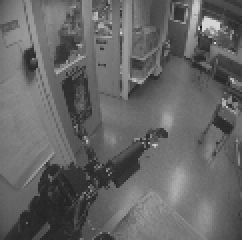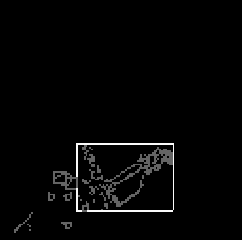Motion Detection and Segmentation |
||
| Motion Detection and Segmentation MIT Artificial Intelligence Laboratory 545 Technology Square, #920 Cambridge, MA 02139 |
The ProblemTo locate visual motion within the wide-angle visual fields. Our ApproachThe motion detection module receives a wide-angle camera image as input and computes the difference between consecutive images within a local field. The motion segmenter then uses a region-growing technique to identify contiguous blocks of motion within the difference image. The motion detection process receives a digitized 120x120 image from the left wide camera. Incoming images are stored in a ring of three frame buffers; two frame buffers hold the current complete image and the previous complete image while the extra frame buffer is being written to. The absolute value of the difference between the grayscale values in each image is thresholded to provide a raw motion image. The raw motion image is then used to produce a motion receptive field map. The receptive field map is a 40x40 array in which each cell corresponds to the number of cells in a 3x3 receptive field of the raw motion image that are above threshold. This reduction in size allows for greater noise tolerance and increased processing speed in the motion segmentation module. The motion segmentation module takes the receptive field map from the motion detection processor and produces a bounding box for the largest contiguous motion group. The process scans the receptive field map marking all locations which pass threshold with an identifying tag. Locations inherit tags from adjacent locations through a region grow-and-merge procedure. Once all locations above threshold have been tagged, the tag that has been assigned to the most locations is declared the ``winner''. StatusThe motion detection and segmentation processes are fully implemented. In order to operate at speeds close to frame rate, the motion detection and segmentation routines were divided between two processors. ResultsThe following pictures summarize the results of the algorithm. The first image is Cog's view of its left arm. The second image is the result of the motion detection and segmentation algorithm just after the arm started moving.
The motion detection algorithm produces a rough outline of the moving arm while the segmenter combines these to produce the solid white box that outlines the area containing the largest block of contiguous motion. FutureA more detailed concept of motion will be more useful in later processing stages. We especially will need to incorporate information on the direction of motion, as produced by optic flow algorithms.
|
|
Representatives of the press who are interested in acquiring further information about the Cog project should contact Elizabeth Thomson, thomson@mit.edu, from the MIT News Office, http://web.mit.edu/newsoffice/www/ . |
||

